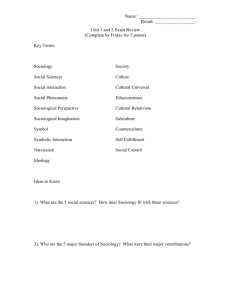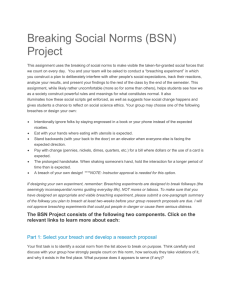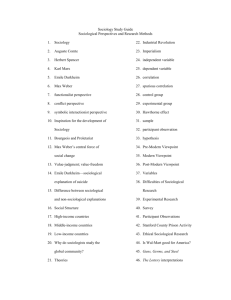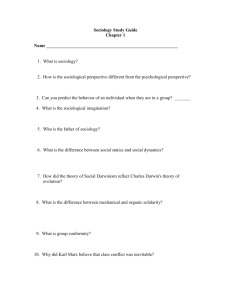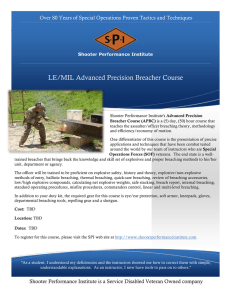Experiential Learning in SOC 100 Introduction to Sociology:
advertisement
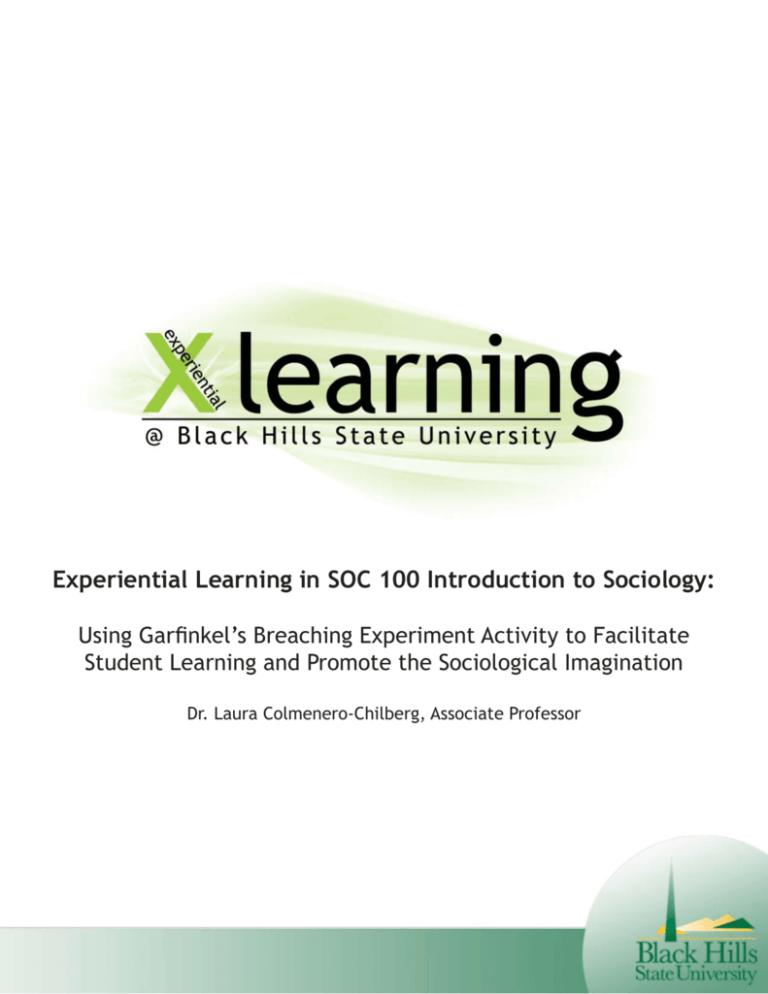
Experiential Learning in SOC 100 Introduction to Sociology: Using Garfinkel’s Breaching Experiment Activity to Facilitate Student Learning and Promote the Sociological Imagination Dr. Laura Colmenero-Chilberg, Associate Professor Overview Overview of Project This Scholarship of Teaching & Learning project discusses the use of Garfinkel’s breaching experiment activity as a pedagogical tool that can be used to (1) increase student learning through the application of theoretical concepts in an experiential framework and (2) help promote the development of the sociological lens in predominantly non-sociology majors. Consequently, the project asked: How can experiential learning activities, where students are asked to develop linkages between academic classroom material and the “real” world increase student engagement and improve learning? How does an experiential learning activity that engages student learners also help develop their sociological imagination, that unique lens for looking at the social world that we seek to help students develop in the Introduction to Sociology class? “Taking part in the experiment really helped my partner and I see that society is conformed to certain norms. The hands on experience is something one physically takes part in and remembers reactions of others better then reading about what reactions happen in a book.” Student Participant 2 Description Description of Project “Students develop a greater understanding of and appreciation for sociology if they are able to relate it to their own experience” (Misra 2000, p. 346) and “[S]ociology may be at its most meaningful when students temporarily separate themselves from conventional modes of inquiry and involve themselves with the everyday contexts within which sociological concepts are actually at work” (Rafalovich 2006, p. 156). Harold Garfinkel (1967), a modern ethnomethodologist, developed one of the best known field research activities for students – the breaching experiment – where students break a social rule (folkway) and observe the verbal and non-verbal responses (sanctions) of those who view the cultural mis-step, investigating “the role that a background of common understandings plays in the production, control and recognition” of reality (Garfinkel 1967, p. 49). The dual role played by student researchers in this area – both subjective participant and objective observer of others and themselves – provides the opportunity to look at the social world through this sociological lens. “I thought the breaching experiement was very helpful in helping me to understand and see first hand how people react when social norms are broken. I got to experience and observe being sanctioned both positively and negatively.” Student Participant Garfinkel, Harold. 1967. Studies in Ethnomethodology. Englewood Cliffs, NJ: Prentice Hall. Misra, Joya. 2000. “Integrating ‘The Real World’ into Introduction to Sociology: Making Sociological Concepts Real.” Teaching Sociology 28:346-363. Rafalovich, Adam. 2006. “Making Sociology Relevant: The Assignment and Application of Breaching Experiments.” Teaching Sociology 34:156-163. 3 Description Description of Project Students were pretested on sociological information about deviance and social control. Reading and short classroom lectures were provided on deviance, social control, methods of field research and field note taking. Also, a short practice field note taking activity was completed where students selected a public place to observe and take field notes. Students received feedback from the instructor on these field notes. The instructor modeled a folkway breach at the beginning of a class period. The instructor and another faculty member role-played verbal and behavioral breaches of normative faculty behaviors in a public setting. After the role play was completed, the instructor returned to her lecture rather than immediately discussing the incident with the class in order to give students an opportunity to process what they had witnessed. After 10 minutes of class lecture she stopped, explained that the incident was a role play, and asked students to individually make notes on three items related to what they had witnessed: (1) What verbal behaviors of social control did they hear? (2) What physical behaviors of social control did they see? (3) What internal response did the student him/herself have to these methods of social control? A general class discussion was then held on these items. “I really enjoyed doing the breaching experiment. It was fun to apply the things that we learned in class to something in real life; it seems like it makes the concepts we learn in class more comprehensible and more in grained in your mind. By the time you take the test a lot of the key terms you learned while doing the breaching experiment seem second nature to you.” Student Participant 4 Description Description of Project Students self-selected partners and the dyads brainstormed a common folkway to breach. The professor reviewed each folkway to determine potential levels of disruption and harm to the student researchers and members of the public who would view the breaching. If the folkway was considered dangerous or too disruptive, students were guided to modify their choice or to select a new one. Student pairs completed the breaching activity. One member of the pair breached the norm while the other took field notes on verbal and behavioral indicators of social control. When the first breach was completed, the student who had breached the norm took her/his own field notes while reflecting on the experience. The pair moved to a second location and switched roles, repeating the same process. Immediately after both members of the dyad had completed the breaching activity, they together reflected on the experience, adding to their field notes. The dyad then wrote a graded reflective and analytical paper on the activity (see Appendices 1 and 2 for the assignment sheet and the grading rubric). In class several pairs grouped together to discuss what they experienced, looking for common conceptual themes about the experience. Small groups reported their discussions in a large group discussion. Students were post tested on sociological information about deviance and social control. Students took an opinion survey where they were asked the following question: Did you think engaging in the breaching experiment experiential activity helped you understand the concepts of deviance and social control better than you would have with only classroom instruction and reading? Please explain why you answer this way.” Twenty-one students chose to answer the question. They posted their answers anonymously on the class’s Desire2Learn web site. Students took a unit test which included a broader set of information about deviance, social control, as well as some information on stratification and social class. 5 Outcomes & Analysis Project Outcome & Analysis There were two intended outcomes developed at the beginning of this project to be achieved by implementation of the set of activities in the Introduction to Sociology classroom. Given an experience with breaching social norms and related reflective practice, students will be able to (1) identify verbal and behavioral indicators of social control and (2) recognize how verbal and behavioral indicators of social control affect self. When we limit our attention to just the three groups compared here, we can conclude that there appeared to be improved student learning through the use of an experiential learning activity. The data from pre to post test, the demonstration of understanding in the reflective and analytical papers as indicated by the grades, and even in a small measure the level of mastery on the unit tests all indicated improvements in student learning. In addition, students overwhelmingly explained that they perceived the value of this kind of experiential learning in improving their ability to master the learning. For this reason, there is some support for the idea that experiential learning increases student engagement which results in improved student learning. To translate this into sociological language, we can say that experiential learning decreased student alienation which resulted in improved student learning through use of the sociological perspective. “Approaching the activity in this hyper-conscious way should strengthen the potential for learning by the students in my Introduction to Sociology classrooms. The process shows improved engagement, and with improved engagement there is improved student learning, demonstrated in the data that was collected. On many levels this experience was a true success.” 6 Outcomes & Analysis Project Outcome & Analysis In addition, I believe we may also be seeing “instructor” and “campus project” effects here. I was very excited about the project, and I believe that level of excitement may have affected the results. I have always enjoyed working with students on this assignment, but because of the project I believe that enjoyment was more intense. Authentic excitement can’t be faked, and this may have artificially increased student excitement and engagement and this level of interest may not be maintained every semester the activity is used. One final concern related to use of this activity, the community in which the university is located is under 25,000 people. There are a limited number of public spaces in which students can engage in the breaching experiments, and soon the activity will become pretty common knowledge. When we reach that point, the behavioral responses will change, and they will no longer be authentic, inhibiting the learning experience of students. “I thought that the breaching experiment was very helpful towards learning. I am a hands on, very visual learner. I tend to understand things more if I engage in it. The breaching experiment was very helpful for me.” Student Participant 7 erformance & Conclusion Student Performance & Conclusion Changes in the assessments and data collection could include the following: • More data needs to be collected from additional groups of students. • The outcomes need to be refined to more closely address the intended student learning. • Inclusion of field notes samples from the practice assignment to compare with field notes turned in with reflective and analytical paper could be an additional source of data. • Include a component where group members peer review practice field notes in addition to the instructor feedback. • A refined measure for identifying changes in student identity to including the sociological imagination needs to be developed. • Make sure to pre and post test all future samples. • Give a unit test that only includes information on deviance and social control. • Build the field observation and field note taking sections into earlier units of the class in order to give students the ability to fine-tune this skill. Consider placing it in either the Culture or Socialization units, or in both. “As always, small samples prevent broad generalizations. The value of the results of this small study, however, is clear and provides support for continued use of the breaching experiment activity in the Introduction to Sociology classroom.” “The responses I received when I broke the norm were expected. I could have easily grasped the idea of social control from reading about the breaching experiment in a book. However, my aversion to breaking the norm and the emotions that accompanied that aversion would not have been accessible had I not participated in the experiment. My experience gave me a better understanding of the power of social control.” Student Participant 8


